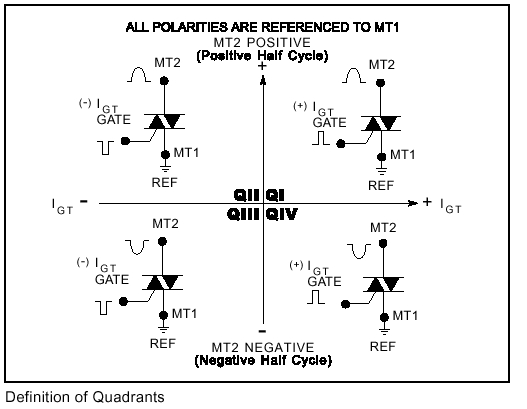Home › Electrical Engineering Forum › General Discussion › Single and Bidirectional Phase Controlled Thyristors
- This topic has 0 replies, 1 voice, and was last updated 10 years ago by
admin.
-
AuthorPosts
-
2014/11/21 at 7:05 pm #11212
admin
KeymasterAfter a focus on the different types of thyristors, one of our member decided to share information about single and bi-directional thyristors. Hope you’ll enjoy his sharing.
Introduction
One directional thyristor, also known as Silicon Controller Rectifier (SCR), is actually nothing more than a simple four layered current controlling device that allows passing current only in one direction. It has three junctions and three terminals. The device operates if current passes through the gate of the thyristor that is connected to the p-type material nearest to cathode.
Bi-directional thyristor, TRIAC or triode for alternating current all is the names of a same device that conducts current only two directions. Either positive or negative current can enable flow and active its gate electrode. Once the device is triggered, it then stop conducting if the current value falls from a threshold value known as Holding Current.Operating Characteristics
UNI-Directional
SCR works in 3 modes depending upon its biasing:
- Forward blocking mode: In this mode, two junctions J1 and J3 are forward biased while the junction J2 is reversed biased due to which very small leakage current flows from anode to cathode until junction J2 reaches at its avalanche breakdown.
- Forward Conduction mode:
This mode can be activated either by increasing anode to cathode voltage or by giving gate a positive pulse. The only way to turn it off is by minimizing the current less than holding current and after starting conduction, gate voltage is no more of any importance here. - Reverse Blocking mode:
This mode is used in current source inverters and has capability of blocking reverse voltage of thyristors. SCR’s that are not capable of blocking reverse voltage are known as asymmetrical SCR.
TRIACS
TRIACS have two terminals M1 and M2 and its working is explained by triggering it in each of the four quadrants. In the first and second quadrants, current flows from M2 to M1 while in the third and fourth quadrants the current flows from M1 to M2. Though the sensitivity depends upon the physical structure of bi-directional thyristor but usually quadrant 1 is most sensitive because the minimum gate current required for this and quadrant 4 is considered as the least sensitive.
To improve the commutation characteristics, only the first three quadrants are used. Bi-directional thyristors are actually two anti-parallel thyristors integrated on a same silicon chip with a central metallization gate. Each half performs its specific function corresponding to its dynamic and static properties. For each current direction mechanical components like insulators, clamps and heat sinks have to be used.
Advantages and Applications
Both Bi-directional and one directional thyristors have their own applications but the major advantage of a bi-directional thyristor is that this single component can be used at the place of two thyristors i.e. it requires less components with high installation reliability. So, it saves cost for almost 30% compared to a conventional system.
TRIACS are usually also used in “snubber circuits” which prevents from premature triggering of device. TRIACs are suitable for AC voltage control circuits, phase control and motor control circuits, industrial drives etc.
Due to their extensive and controlled electrical properties they are widely used in DC electric circuits as a better replacement for electric circuit breakers. It should be noted here that they show better grounding properties than common circuit breakers, which able them to find wide uses in electric circuits. As told earlier electrical power conversion is also accomplished with the help of thyristors.
SCR are used in the systems where high power coupled with high voltage is required and in medium to high voltage power supplies such as regulators, welding machines, lamps, in small and major appliances of house etc.
Thanks for reading,
Nasir.
Did your learn some things thanks to this article? We hope so!
-
AuthorPosts
- You must be logged in to reply to this topic.

